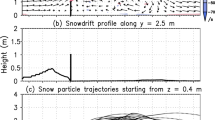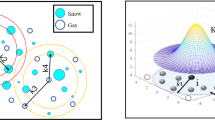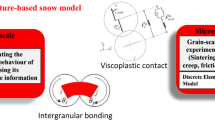Abstract
This paper introduces a novel workflow to generate snow imprints, and model the interaction of snow with dynamic objects. We decoupled snow simulation into three components: a base layer, snow particles, and snow mist. The base layer consists of snow that has not been in contact with a dynamic object yet, and is stored as a level set. Snow particles model the interaction between the snow and the dynamic objects. They are added when the dynamic objects collide with the base layer, and are animated using an adapted granular material simulation. The very thin and powdery snow released by airborne snow particles is modeled by the snow mist. This component is greatly influenced by the surrounding air medium; thus, it is animated using a fluid simulation. This decomposition allows to focus memory expensive and time-consuming computations only where dynamic objects interact with the snow, which is much more efficient than relying on a full-scale simulation.













Similar content being viewed by others
References
Alduán, I., Otaduy, M.A.: SPH granular flow with friction and cohesion. In: Proc. of ACM SIGGRAPH/Eurographics symposium on computer animation, pp. 25–32 (2011)
Bell, N., Yu, Y., Mucha, P.J.: Particle-based simulation of granular materials. In: Proc. of ACM SIGGRAPH/Eurographics symposium on computer animation, pp. 77–86 (2005)
Bronstein, A., Bronstein, M., Kimmel, R.: Numerical geometry of non-rigid shapes. Springer, New York (2008)
Fearing, P.: Computer modelling of fallen snow. In: Proc. of SIGGRAPH 2000, annual conference series, pp. 37–46 (2000)
Feldman, B.E., O’Brien, J.F.: Modeling the accumulation of wind-driven snow. In: SIGGRAPH 2002 conference abstracts and applications, pp. 218–218. ACM (2002)
Festenberg, N.V., Gumhold, S.: A geometric algorithm for snow distribution in virtual scenes. In: Eurographics workshop on natural phenomena, pp. 15–25 (2009)
Festenberg, N.V., Gumhold, S.: Diffusion-based snow cover generation. Comput. Graph. Forum 30(6), 1837–1849 (2011)
Ihmsen, M., Wahl, A., Teschner, M.: A lagrangian framework for simulating granular material with high detail. Comput. Graph. 37(7), 800–808 (2013)
Lenaerts, T., Dutré, P.: Mixing fluids and granular materials. Comput. Graph. Forum 28(2), 213–218 (2009)
Macklin, M., Müller, M., Chentanez, N., Kim, T.Y.: Unified particle physics for real-time applications. ACM Trans. Graph. 33(4), 153:1–153:12 (2014)
Maréchal, N., Guérin, E., Galin, E., Mérillou, S., Mérillou, N.: Heat transfer simulation for modeling realistic winter sceneries. Comput. Graph. Forum 29(2), 449–458 (2010)
Moeslund, T.B., Madsen, C.B., Aagaard, M., Lerche, D.: Modeling falling and accumulating snow. In: Vision, video and graphics, vol. 2 (2005)
Müller, M., Heidelberger, B., Hennix, M., Ratcliff, J.: Position based dynamics. J. Vis. Commun. Image Represent. 18(2), 109–118 (2007)
Museth, K., Breen, D.E., Whitaker, R.T., Barr, A.H.: Level set surface editing operators. ACM Trans. Graph. 21(3), 330–338 (2002)
Museth, K., Lait, J., Johanson, J., Budsberg, J., Henderson, R., Alden, M., Cucka, P., Hill, D., Pearce, A.: OpenVDB: an open-source data structure and toolkit for high-resolution volumes. In: SIGGRAPH 2013 Courses, p. 19. ACM (2013)
Narain, R., Golas, A., Lin, M.C.: Free-flowing granular materials with two-way solid coupling. ACM Trans. Graph. 29(6), 173:1–173:10 (2010)
Onoue, K., Nishita, T.: An interactive deformation system for granular material. Comput. Graph. Forum 24(1), 51–60 (2005)
Pla-Castells, M., García-Fernández, I., Martinez-Dura, R., et al.: Physically-based interactive sand simulation. In: Eurographics 2008, short papers, pp. 21–24 (2008)
Stomakhin, A., Schroeder, C., Chai, L., Teran, J., Selle, A.: A material point method for snow simulation. ACM Trans. Graph. 32(4), 102 (2013)
Sumner, R.W., O’Brien, J.F., Hodgins, J.K.: Animating sand, mud, and snow. Comput. Graph. Forum 18(1), 17–26 (1999)
Takahashi, T., Fujishiro, I.: Particle-based simulation of snow trampling taking sintering effect into account. In: SIGGRAPH 2012 posters, p. 7. ACM (2012)
Wang, C., Wang, Z., Xia, T., Peng, Q.: Real-time snowing simulation. Vis. Comput. 22(5), 315–323 (2006)
Wong, S.K., Fu, I., et al.: Hybrid-based snow simulation and snow rendering with shell textures. Comput. Anim. Virtual Worlds 26(3–4), 413–421 (2015)
Zeng, Y.L., Tan, C.I., Tai, W.K., Yang, M.T., Chiang, C.C., Chang, C.C.: A momentum-based deformation system for granular material. Comput. Anim. Virtual Worlds 18(4–5), 289–300 (2007)
Zhu, B., Yang, X.: Animating sand as a surface flow. Eurographics 2010, Short Papers. Norrköping, Sweden (2010)
Zhu, Y., Bridson, R.: Animating sand as a fluid. ACM Trans. Graph. 24(3), 965–972 (2005)
Acknowledgments
This work was funded by Mokko Studio, Mitacs, Prompt, and École de technologie supérieure. We would like to thank employees of Mokko Studio for their feedback throughout the project. We would also like to thank SideFX™ for providing Houdini™ licenses for research. We would like to thank Bruno Roy as well for the walk animation. Lastly, we thank the anonymous reviewers for their thoughtful comments and suggestions.
Author information
Authors and Affiliations
Corresponding author
Rights and permissions
About this article
Cite this article
Dagenais, F., Gagnon, J. & Paquette, E. An efficient layered simulation workflow for snow imprints. Vis Comput 32, 881–890 (2016). https://doi.org/10.1007/s00371-016-1261-9
Published:
Issue Date:
DOI: https://doi.org/10.1007/s00371-016-1261-9




